Complete Solutions to SECTION - II of chapter SELF ASSESSMENT PAPER 3 of Class 10 book with complete answers and questions
| Class 10 | BIOLOGY |
| Chapter | SELF ASSESSMENT PAPER 3 |
| OSWAL | SECTION - II |
| Number Of Questions | 59 |
| Academic Year | 2023-24 |
A potted plant with variegated leaves was taken in order to prove a factor necessary for photosynthesis. The potted plant was kept in the dark for 24 hours and then placed in bright sunlight for a few hours Observe the diagrams and answer the questions.
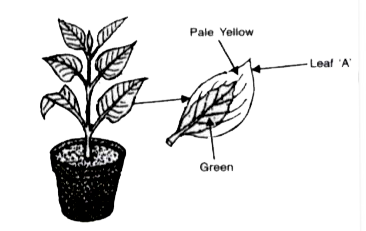
What aspect of photosynthesis is being tested in the above diagram?
View SolutionA potted plant with variegated leaves was taken in order to prove a factor necessary for photosynthesis. The potted plant was kept in the dark for 24 hours and then placed in bright sunlight for a few hours Observe the diagrams and answer the questions.
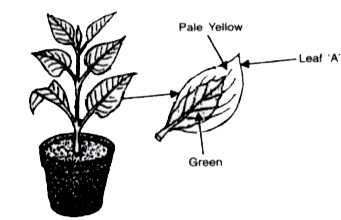
Why was the plant kept in the dark before beginning the experiment?
View SolutionA potted plant was taken in order to prove a factor necessary for photosynthesis. The potted plant was kept in the dark for 24 hours. One of the leaves was covered with black paper in the centre. The potted plant was then placed in sunlight for a few hours.

During the starch test, why was the leaf: (1) boiled in water (2) boiled in methylated spirit
View SolutionThe diagram given below is an experiment conducted to study a factor necessary for photosynthesis Observe the diagram and then answer the following questions
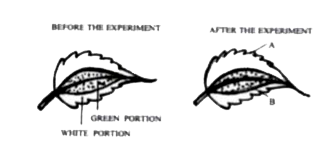
Give a balanced chemical equation to represent the process of photosynthesis
View SolutionA potted plant with variegated leaves was taken in order to prove a factor necessary for photosynthesis. The potted plant was kept in the dark for 24 hours and then placed in bright sunlight for a few hours Observe the diagrams and answer the questions.
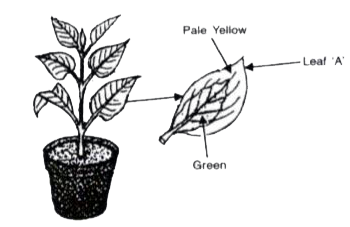
Draw a neat labelled diagram of a chloroplast
View SolutionExplain the following terms:
Plasmolysis
View SolutionExplain the following term :
Turgor pressure.
View SolutionWrite short notes on :
Selective reabsorption
View SolutionHypotonic and Hypertonic solution
View SolutionBriefly explain the following:
Pulse
View SolutionThe diagram below represents the structure found in the inner ear. Study the same and then answer the questions which follow:
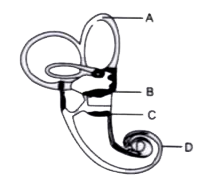
Name the parts labelled A, B, C and D.
View SolutionName the part of the ear responsible for transmitting impulses to the brain.
View SolutionThe diagram below represents the structure found in the inner ear.
Study the same and then answer the questions that follow:

Name the part labelled above which is responsible for :
(1) Static equilibrium.
(2) Dynamic equilibrium.
(3) Hearing.
View SolutionName the audio receptor cells which pick up vibrations.
View SolutionThe diagram below represents the structure found in the inner ear. Study the same and then answer the questions which follow:

Name the fluid present in the inner ear.
View SolutionGive one difference between the following pairs on the basis of what is given in brackets :
Myopia and Hypermetropia. (Cause of the defect)
View SolutionDifferentiate between : Cerebrum and Spinal cord (Arrangement of cytons and axons of neurons).
View SolutionGive one point of difference between the following on the basis of what is given in the brackets:
Red blood corpuscles and white blood corpuscles (origin)
View SolutionDifferentiate between :
Karyokinesis and Cytokinesis (Explain the terms)
View SolutionGive one point of difference between the following on the basis of what is given in the brackets:
Light reaction and dark reaction (site of occurrence)
View SolutionGiven below is a diagram representing a stage during mitotic cell division.
Study it carefully and answer the questions that follow:
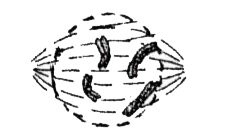
Is it a plant cell or an animal cell? Give a reason to support your answer.
View SolutionGiven below is a diagram representing a stage during mitotic cell division.
Study it carefully and answer the questions that follow:

Identify the stage shown above.
View SolutionGiven below is a diagram representing a stage during mitotic cell division. Study it carefully and answer the questions that follow :
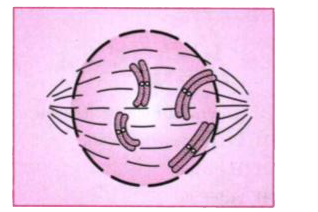
Name the stage that follows the one shown here. How is that stage identified ?
View SolutionGiven below is a diagram representing a stage during mitotic cell division.
Study it carefully and answer the questions that follow:
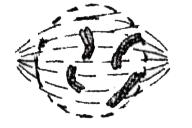
How will you differentiate between mitosis and meiosis on the basis of the chromosome number in the daughter cells?
View SolutionGiven below is a diagram representing a stage during mitotic cell division.
Study it carefully and answer the questions that follow:

Draw a duplicated chromosome and label its parts.
View SolutionThe stain used while examining blood corpuscles.
View SolutionThe pressure at the time when the fresh blood is pumped into the arteries.
View SolutionThe shortest stage of mitosis.
View SolutionThe condition due to a blockage in the coronary artery.
View SolutionGive technical term :
Non-identical twins produced by the fertilisation of two eggs.
View SolutionThe diagram below shows two test-tubos A and B. Test-tube A contains a green water plant Test-tube B contains both a green water plant and a snail. Both test tubes are kept in sunlight Answer the questions that follow
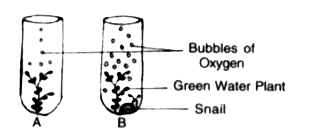
Name the physiological process that releases the bubbles of oxygen
View SolutionThe diagram below shows two test-tubes A and B. Test-tube A contains a green water plant Test-tube B contains both a green water plant and a snail. Both test tubes are kept in sunlight Answer the questions that follow
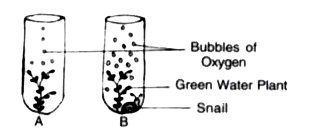
Explain the physiological process as mentioned above
View SolutionThe diagram below shows two test-tubes A and B. Test-tube A contains a green water plant Test-tube B contains both a green water plant and a snail. Both test tubes are kept in sunlight Answer the questions that follow
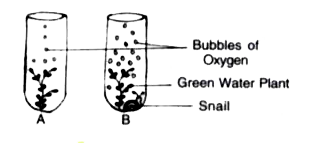
What is the purpose of keeping a snail in test-tube "B?
View SolutionThe diagram below shows two test-tubes A and B. Test-tube A contains a green water plant Test-tube B contains both a green water plant and a snail. Both test tubes are kept in sunlight Answer the questions that follow
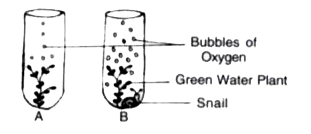
Write the overall chemical reaction for the above process.
View SolutionThe diagram below shows two test-tubes A and B. Test-tube A contains a green water plant Test-tube B contains both a green water plant and a snail. Both test tubes are kept in sunlight Answer the questions that follow

Write the overall chemical reaction for the above process.
View SolutionDraw a diagram of the human eye as seen in a vertical section and label the parts which suits the following functions/descriptions :
The layer which prevents reflection of light.
View SolutionDraw a diagram of the human eye as seen in a vertical section and label the parts which suits the following functions/descriptions :
The structure that alters the focal length of the lens.
View SolutionDraw a diagram of the human eye as seen in a vertical section and label the parts which suits the following functions/descriptions :
The region of distinct vision.
View SolutionDraw a diagram of the human eye as seen in a vertical section and label the parts which suits the following functions/descriptions :
The part which transmits the impulse to the brain.
View SolutionDraw a diagram of the human eye as seen in a vertical section and label the parts which suits the following functions/descriptions :
The outermost transparent layer in front of the eye lens.
View SolutionDraw a diagram of the human eye as seen in a vertical section and label the parts which suits the following functions/descriptions :
The fluid present in the anterior part of the eye in front of the eye lens.
View SolutionThe diagram given below is a representation of a phenomenon pertaining to the nervous system. Study the diagram and answer the following questions:
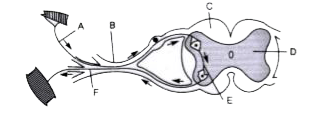
(i) Name the phenomenon that is being depicted.
(ii) Give the technical term for the point of contact between the two nerve cells.
(iii) Name the parts A, B, C and D.
(iv) Write the functions of parts E and F.
(v) How does the arrangement of neurons in the spinal cord differ from that of the brain.
View SolutionThe diagram given below is a representation of a phenomenon pertaining to the nervous system. Study the diagram and answer the following questions:

(i) Name the phenomenon that is being depicted.
(ii) Give the technical term for the point of contact between the two nerve cells.
(iii) Name the parts A, B, C and D.
(iv) Write the functions of parts E and F.
(v) How does the arrangement of neurons in the spinal cord differ from that of the brain.
View SolutionThe diagram given below is a representation of a phenomenon pertaining to the nervous system. Study the diagram and answer the following questions:

(i) Name the phenomenon that is being depicted.
(ii) Give the technical term for the point of contact between the two nerve cells.
(iii) Name the parts A, B, C and D.
(iv) Write the functions of parts E and F.
(v) How does the arrangement of neurons in the spinal cord differ from that of the brain.
View SolutionThe diagram given below is a representation of a phenomenon pertaining to the nervous system. Study the diagram and answer the following questions:

(i) Name the phenomenon that is being depicted.
(ii) Give the technical term for the point of contact between the two nerve cells.
(iii) Name the parts A, B, C and D.
(iv) Write the functions of parts E and F.
(v) How does the arrangement of neurons in the spinal cord differ from that of the brain.
View SolutionHow does the arrangement of neurons in the spinal cord differ from that of the brain?
View SolutionMention three adaptations found in plants to reduce transpiration.
View SolutionGive scientific reasons for the following statements:
We feel blinded for a short while entering a dark room when coming from bright light.
View SolutionExplain how the rate of transpiration Is affected on :
a windy day
View SolutionA nitrogenous base in DNA.
View SolutionThe pigment present in red blood cells.
View SolutionThe given diagram represents a nephron and its blood supply. Study the diagram and answer the question :
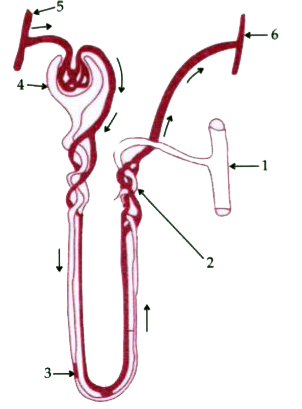
Label parts 1, 2, 3 and 4.
View SolutionThe given diagram represents a nephron and its blood supply. Study the diagram and answer the question :

State the reason for the high hydrostatic pressure in the glomerulus.
View SolutionThe given diagram represents a nephron and its blood supply. Study the diagram and answer the question :
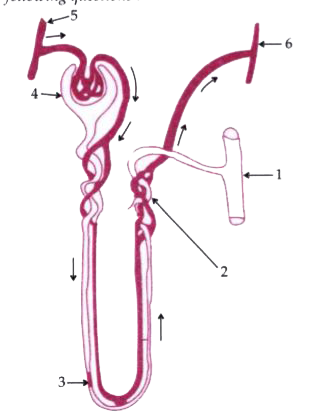
Name the blood vessel which contains the least amount of urea in this diagram.
View SolutionThe given diagram represents a nephron and its blood supply. Study the diagram and answer the following questions:

Name the two main stages of urine formation.
View SolutionThe given diagram represents a nephron and its blood supply. Study the diagram and answer the following questions:

Name the part of the nephron which lies in the renal medulla.
View SolutionMention the effets of two individuals in a street fight on the following organs by the autonomous nervous system (one has been done for you).

View SolutionGive the specific function of:
(i) Centrosome
(ii) Stoma
(iii) Transpiration
(iv) Ureter
(v) Vitreous humour
View SolutionName the following :
That part of the chloroplast where the light reaction of photosynthesis takes place.
View Solution
SECTION - II questions and complete solutions for chapter SELF ASSESSMENT PAPER 3 of EVERGREEN BIOLOGY (ENGLISH) of Class 10